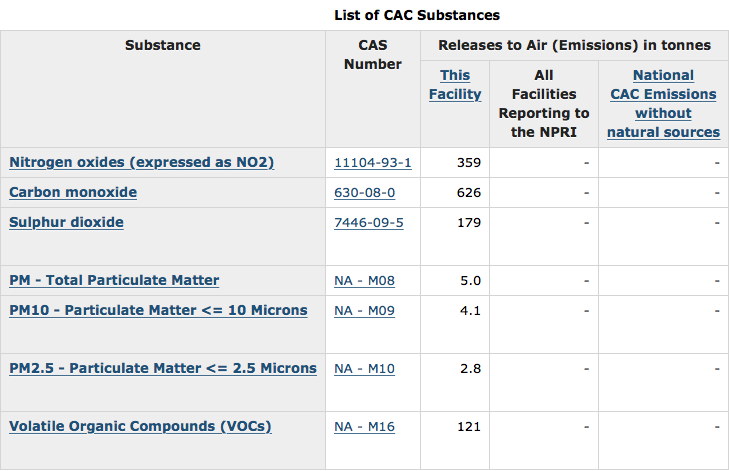 Pulp and Paper Toxic Emissions
Pulp and Paper Toxic Emissions
Catalyst Port Alberni submits annual emissions figures for about 50 substances of concern to the National Pollution Release Inventory.
Five of these are for the five main Criteria Air Contaminants, discussed earlier:
CEPA TOXIC SUBSTANCES
 For more information on CACs go to:
CRITERIA AIR CONTAMINANTS
Other CEPA Toxic substances, with a 5 year trend analysis, that are most relevant to the pulp and paper industry include:
Dioxins and Furans
These persistent, organic pollutants are carcinogens, endocrine disrupters, and developmental/reproductive toxins. They cause immune disruptions, skin disorders, cardiovascular disease, and diabetes.
More info on dioxins
Hexachlorobenzene
The main exposure of this carcinogen is through food, although it is toxic when inhaled. It causes kidney and liver damage, central nervous system effects, and potential foetal damage.
Acetaldehyde
Is implicated in ozone formation. It effects the upper respiratory tract. It may also affect the brain, eye, lung, nose skin, and throat.
Formaldehyde
Low levels can cause eye, nose, throat, and skin irritation.
Polycyclic Aromatic Hydrocarbons (PAHs)
This family represents about 100 compounds that are products of incomplete combustion. The most relevant here are Phenanthrene, Fluoranthene, and Pyrene.
Several PAHs are possible or known carcinogens. They can also cause birth defects, and are toxic to the skin, blood, reproductive and immune systems in animals.
Metals
Arsenic, Hexavalent Chromium Compounds, Lead, and Cadmium pose health concerns related to pulp and paper production. Health effects include neurotoxicity, reproductive disorders, kidney and liver disease, and cancer.
Ammonia
Is highly toxic to fish and other animals.
Carbon Tetrachloride and Chloroform
These are also CEPA Toxic emissions associated with pulp and paper mills but are not reported to NPRI.
HAZARDOUS AIR POLLUTANTS
These are other chemicals of concern that are derived from pulp and paper processes. From a list, those with emission concentrations found to be significant are:
Methanol
For more information on CACs go to:
CRITERIA AIR CONTAMINANTS
Other CEPA Toxic substances, with a 5 year trend analysis, that are most relevant to the pulp and paper industry include:
Dioxins and Furans
These persistent, organic pollutants are carcinogens, endocrine disrupters, and developmental/reproductive toxins. They cause immune disruptions, skin disorders, cardiovascular disease, and diabetes.
More info on dioxins
Hexachlorobenzene
The main exposure of this carcinogen is through food, although it is toxic when inhaled. It causes kidney and liver damage, central nervous system effects, and potential foetal damage.
Acetaldehyde
Is implicated in ozone formation. It effects the upper respiratory tract. It may also affect the brain, eye, lung, nose skin, and throat.
Formaldehyde
Low levels can cause eye, nose, throat, and skin irritation.
Polycyclic Aromatic Hydrocarbons (PAHs)
This family represents about 100 compounds that are products of incomplete combustion. The most relevant here are Phenanthrene, Fluoranthene, and Pyrene.
Several PAHs are possible or known carcinogens. They can also cause birth defects, and are toxic to the skin, blood, reproductive and immune systems in animals.
Metals
Arsenic, Hexavalent Chromium Compounds, Lead, and Cadmium pose health concerns related to pulp and paper production. Health effects include neurotoxicity, reproductive disorders, kidney and liver disease, and cancer.
Ammonia
Is highly toxic to fish and other animals.
Carbon Tetrachloride and Chloroform
These are also CEPA Toxic emissions associated with pulp and paper mills but are not reported to NPRI.
HAZARDOUS AIR POLLUTANTS
These are other chemicals of concern that are derived from pulp and paper processes. From a list, those with emission concentrations found to be significant are:
MethanolManganese Compounds
Hydrogen Sulphide
Hydrochloric Acid
Chlorine
Chlorine Dioxide
Phenol
Methyl Ethyl Keytone Two of these are a special concern: Manganese Compounds In 2010, 14 T of manganese compounds were released into the water, and 42 T were disposed of at the Catalyst landfill. Long term occupational exposure to manganese can cause irreversible damage to areas of the brain controlling balance and fine motor coordination resulting in Parkinson's-like symptoms. Hydrogen Sulphide (H2S) Catalyst reported 14 T of H2S and 274 T of Hydrochloric Acid discharged into the air for 2010.
H2S is often what causes the pulp mill, rotten egg smell. It is just one of a number of compounds referred to as Total Reduced Sulphur (TRS) - and the only one reported to the NPRI. Other TRS substances relevant to pulp and paper are: Methyl Mercaptan
Dimethyl Sulphide
Dimethyl Disulphide. Oxidation products of TRS compounds, like sulphuric acid, contribute to the acidity of the environment. Although each TRS compound has its own related health effects, the most commonly reported effects are nausea and headaches. HIGH PRIORITY SUBSTANCES These are persistent, bio-accumulative, and inherently toxic. Nine of the 15 listed in relation to pulp and paper operations have still not been declared CEPA Toxic. Due to the high level threshold for reporting, very little data for these substances has been reported to the NPRI More information: CITIZENS GUIDE TO NPRI REACH FOR UNBLEACHED